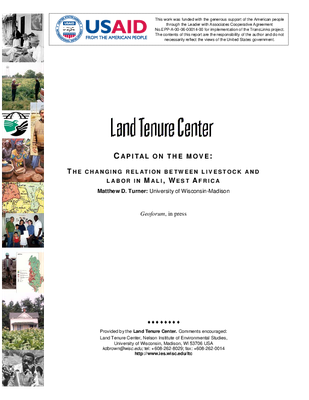Capital on the Move: The Changing Relation between Livestock and Labor in Mali, West Africa
Capital on the Move: The Changing Relation between Livestock and Labor in Mali, West Africa. In dryland areas of Africa, livestock play important economic roles as commodities, wealth stores, producers of products, and agents of environmental change. Conventional depictions of livestock economies in this region have focused (in support or against) on the need for greater engagement of livestock producers with markets supplying meat to urban areas. This paper argues this singular focus has led analysts to ignore two important aspects of livestock economies: livestock as a preferred store of wealth across a wide range of social groups and the need for specialized labor to manage these livestock across open pastures to maintain their productive capacity and limit their negative environmental impacts. In the West African Sahel, the capital-like nature of livestock wealth has become more clear with a growing fraction of the region’s livestock owned by investors with little connection to livestock husbandry. Livestock investments are maintained on a day-to-day basis by hired herders who facilitate access to ephemeral pastures and water. A particular concern is the changing geographies of livestock ownership and the herding labor in relationship to regional pastures (to economic and environmental ends). This relationship will be explored using the case study of the Maasina region of central Mali – a historically important livestock region, which is now undergoing significant labor emigration. Building from a long-term ethnographic engagement with local livestock owners and herders, the results of ownership surveys of livestock herds across a 14- year period and interviews of urban-based emigrants from the study area about investment decisions will be used to analyze the changing geographies of livestock investment and herding labor in the Maasina.
https://biodiversitylinks.org/projects/completed-projects/translinks/translinks-2008/land-tenure-center/CapitalOnTheMove_Report_LTC_2008.pdf/view
https://biodiversitylinks.org/projects/completed-projects/translinks/translinks-2008/land-tenure-center/CapitalOnTheMove_Report_LTC_2008.pdf/@@download/image/image.png
File
Capital on the Move: The Changing Relation between Livestock and Labor in Mali, West Africa
Author(s):
LTC
Publication Date: 2008
Location: Mali, West Africa
DOWNLOAD FILE
Capital on the Move: The Changing Relation between Livestock and Labor in Mali, West Africa. In dryland areas of Africa, livestock play important economic roles as commodities, wealth stores, producers of products, and agents of environmental change. Conventional depictions of livestock economies in this region have focused (in support or against) on the need for greater engagement of livestock producers with markets supplying meat to urban areas. This paper argues this singular focus has led analysts to ignore two important aspects of livestock economies: livestock as a preferred store of wealth across a wide range of social groups and the need for specialized labor to manage these livestock across open pastures to maintain their productive capacity and limit their negative environmental impacts. In the West African Sahel, the capital-like nature of livestock wealth has become more clear with a growing fraction of the region’s livestock owned by investors with little connection to livestock husbandry. Livestock investments are maintained on a day-to-day basis by hired herders who facilitate access to ephemeral pastures and water. A particular concern is the changing geographies of livestock ownership and the herding labor in relationship to regional pastures (to economic and environmental ends). This relationship will be explored using the case study of the Maasina region of central Mali – a historically important livestock region, which is now undergoing significant labor emigration. Building from a long-term ethnographic engagement with local livestock owners and herders, the results of ownership surveys of livestock herds across a 14- year period and interviews of urban-based emigrants from the study area about investment decisions will be used to analyze the changing geographies of livestock investment and herding labor in the Maasina.



